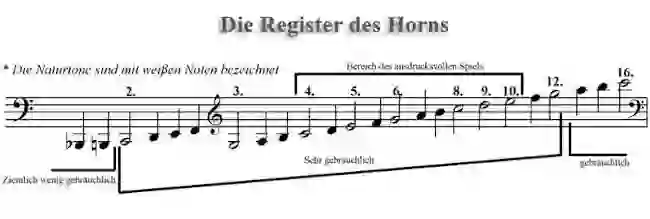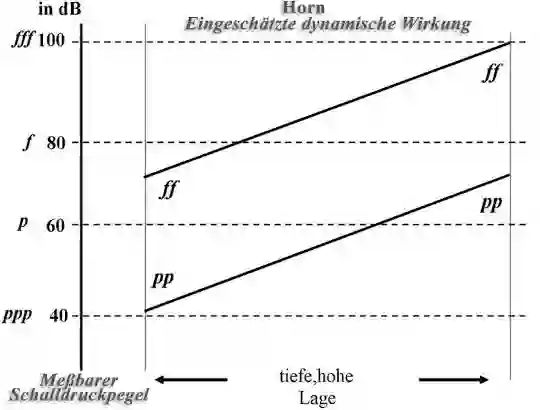Sound character of the Horn - Philipp Dangas
Register table from the horn in F
Structurally, the horn originally nothing more than a trumpet. was If you equip it with a cup mouthpiece and a small bell and blow it open, its sound corresponds to that of a trumpet or trombone. The sound of the horn, which differs greatly from the sound of the other wind instruments, has several reasons.
Reasons for the sound differences between horn and wind instruments
- Due to the considerable length of the tube.
- Due to the almost 2.5 cm deep, conical and relatively narrow funnel mouthpiece.
- Due to the particularly wide sound funnel.
- Through the playing technique of the right hand.
The horn is the most sensitive and technically difficult wind instrument to treat. The entire tone scale of the horn can generally be regarded as tonally very even, only the lowest tones differ from the others. In addition, a distinction is made between "low" and "high" orchestral horn players, due to the extraordinary range of the horn scale and the associated difference in approach.
As part of the „symphonic world music“
The horn is certainly the most important wind instrument in my music. On the one hand, the horn contributes to the realization of the sound and, on the other hand, it also plays the role of mediator (between the woodwind and brass instruments and the strings).
Download size: 135 kilobytes
Table summary of the sound character of the horn
The table below shows the registers and timbres of the trumpet briefly described. The high register becomes the middle register and the deep register described.
Dynamic effect of the horn in F
Sheet music for the dynamic table of the horn in FThe musical dynamics are visible through the different degrees of intensity in the dynamic table. In addition to the sound pressure scale measured in decibels [dB], the degrees of strength of musical dynamics are given on the left, which can be understood as "objective" degrees.
A graphic of the db scale is drawn to the right. It shows the estimated dynamic effect over the entire tonal range of the instrument. The dynamic effect (volume) as judged (perceived) by the listener.
An example of this: In the low register of the trumpet, the dynamic range between pianissimo [pp] 46 decibels [dB] and fortissimo [ff] 82 decibels [dB] = 36 decibels [dB]. In the high register, the range is 8 decibels [dB]. The estimated values can deviate more or less from the "objective" ones.
The deviations vary from instrument to instrument. The mentioned "objective" levels of intensity piano pianissimo [ppp]= 40 decibels [dB], p=60 decibels [dB] etc. enable the composer to predict the dynamic effects of different instruments that are sounding simultaneously.
The achievable dynamic range of the horn - 30 decibels [dB]
The following table shows the achievable dynamic span of the horn shown. The span is the difference between the fortissimo and the Pianissimo in the same pitch.

The register table of the horn in F in a large representation
- hight register
- Brilliant, clear to loud and penetrating
- middle register
- Rich in resonance and full, powerful in forte and soft in piano
- low register
- Quite rough in the forte and best possible effect in the piano.

The dynamic table of the horn in F
Internal search function
| Name | Value | Delete |
|---|